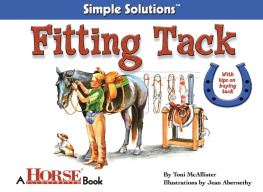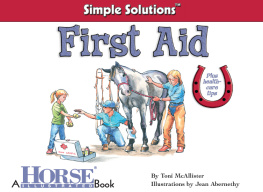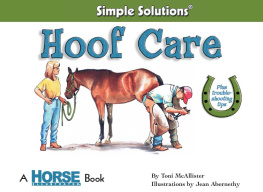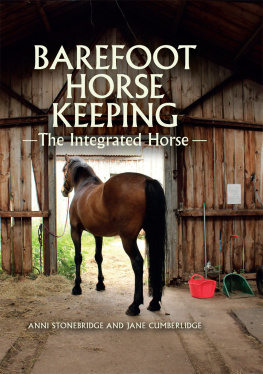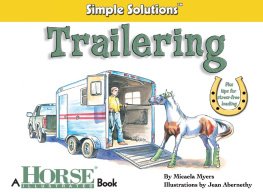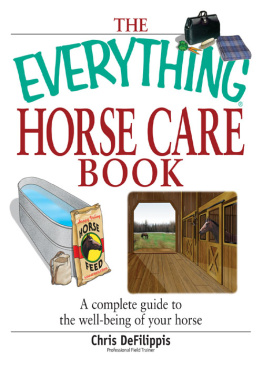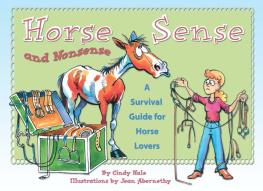Dedication
To Winston and Annieboth have taught me well.
Karla Austin, Business Operations Manager
Nick Clemente, Special Consultant
Barbara Kimmel, Managing Editor
Jessica Knott, Production Supervisor
Amy Stirnkorb, Designer
The horses in this book are referred to as she and he in alternating chapters unless their sexes are apparent from the activities discussed.
Copyright 2007 by I-5 Press
Illustrations 2007 by Jean Abernethy
All rights reserved. No part of this book may be reproduced, stored in a retrieval system, or transmitted in any form or by any means, electronic, mechanical, photocopying, recording, or otherwise, without the prior written permission of I-5 Press, except for the inclusion of brief quotations in an acknowledged review.
McAllister, Toni.
Fitting tack / by Toni McAllister ; illustrations by Jean Abernethy.
p. cm. (Horse illustrated simple solutions)
ISBN-13: 978-1-931993-96-8
ISBN-10: 1-931993-96-3
eISBN: 9781620080825
1. HorsemanshipEquipment and supplies. 2. HorsesEquipment and supplies. I. Title.
SF309.9.M376 2007
636.10837dc22
2006038891
I-5 Press
A Division of I-5 Publishing, LLC
3 Burroughs
Irvine, California 92618
Printed and bound in Singapore
16 15 14 13 12 11 10 09 08 07 1 2 3 4 5 6 7 8 9 10
CONTENTS
Riding Tack: Fit for You and Your Horse
I magine taking a weekend hike wearing boots three sizes too big, a small hat that squeezes your head, and a backpack that rubs uncomfortably. Now picture yourself one hour into that hike. How do you think you might feel? Pretty miserable? These discomforts are what our horses endure when they are expected to work in ill-fitting tack.
Aside from giving your horse discomfort, ill-fitting tack is downright dangerous for both of you. You dont want to be going down the trail on a saddle that slips out of positionyoure likely to fall off, and your horse will probably run loose down the road with a saddle under her belly! Theres no point in tacking up when the tack isnt functional.


Tack also has to fit the rider. If you fuss and fidget, struggling to get comfortable in a saddle thats either too big or too small for you, it worries your horse. For a mount to feel confident with a rider on her back, the rider must be balancednearly impossible in a saddle thats wrong for you! If youre hindered by poor tack fit, your riding skills wont improve, and your time in the saddle will be less enjoyable.
Obtaining equipment that fits properly is the first step toward successful riding, although evaluating fit should be an ongoing process throughout your horses lifetime. Like people, horses change physically as they age. They lose and gain weight, and their musculature changes as their exercise level varies. Consequently, a saddle that fits your horse today may become a torture device for her in later years. (Imagine squeezing into a pair of jeans from your youth, and youll get the picture!) Every time you tack up your horse, you should be checking for fit.
When your horse is outfitted in properly fitted tack and youre comfortable in the drivers seat, riding is more funfor both of you.
Recognizing When Tack Doesnt Fit Your Horse
A well-trained, healthy horse should accept the tack willingly. If youve ever met a sour horse that objected to being tacked up, theres a good chance his equipment didnt fit properly. A horses resistance to being tacked up and his biting or kicking out when the cinch or the girth is tightened are two signs of fit problems.
If tack-fit problems exist, they only get worse during a ride. Unfortunately, a horses irritability caused by poorly fitting tack is sometimes interpreted as bad behavior. The rider thinks, The horse is acting up. In reality, the horse is just trying to communicate that hes in pain. Ouch, that really hurts! isnt in his vocabulary.
Good riders investigate the cause of unwanted behaviors in their horses and look for appropriate solutions. They know that any ill-fitting equipment needs to be replaced or adjusted right away, before it causes long-term health or behavioral problems in their horses.
If your horse demonstrates any of the following behaviors while being ridden, he may be trying to tell you he needs some tack attention:
running off
rearing
bucking
kicking out
inverting neck and hollowing back
tossing head
refusing to accept the bit
pinning the ears
Not every horse will tell you when something doesnt fit. Unfortunately, some stoic mounts carry on without complaint. For these horses, youll need to be extra diligent about watching for the following telltale signs of poor-fitting tack:


Hair loss or raw skin caused by tack that rubs: White spots on some horses withers are examples of what results from saddles that rub. When the affected area is finally allowed to heal, the hair often grows back white in color as a result of the underlying damage.
Small dry spots on your horses back, under his saddle blanket: Look for such areas after a ride; they signal that the saddle is digging into your horses back or pinching at those dry points.
Welts on your horses body wherever tack comes into contact: Welts indicate inflammationa sure sign that something doesnt fit correctly.
A goosey back: After a ride, run your fingers down both sides of your horses back simultaneously, placing your fingers approximately two inches away from his spine and using medium pressure. If he flinches or drops his back under the pressure, hes probably back sore, which could be a sign of poor saddle fit.
A saddle that shifts from side to side, even when the cinch or the girth is tight: A properly fitted saddle should stay in place. Your safety, as well as the horses, is at risk if the saddle slips during a ride.
Horses that are ridden while in pain can become unsound over time. If your horse exhibits any sign of pain, dont make the mistake of thinking hes just overreacting. Replace tack as soon as you detect a problem. Ill-fitting tack will take its toll on your horses health and can lead to irreparable damage. Its always better to pay a little extra up front for good-fitting equipment than to pay later on with your horses well-being.

Sizing Up English and Western Saddles
S addles come in different styles, shapes, colors, and sizes. Within the English and western riding disciplines, there are different types of saddles to choose from. English saddle types include dressage, jumping, eventing, and saddleseat. Western saddle styles include trail, pleasure, reining, roping, barrel racing, cutting, and working horse. Regardless of the type of saddle you choose, there are basic sizing guidelines to follow when it comes to fit for both you and your horse.
In addition to saddles, girths and cinches have to be correctly sized to ensure proper fit.
Next page
